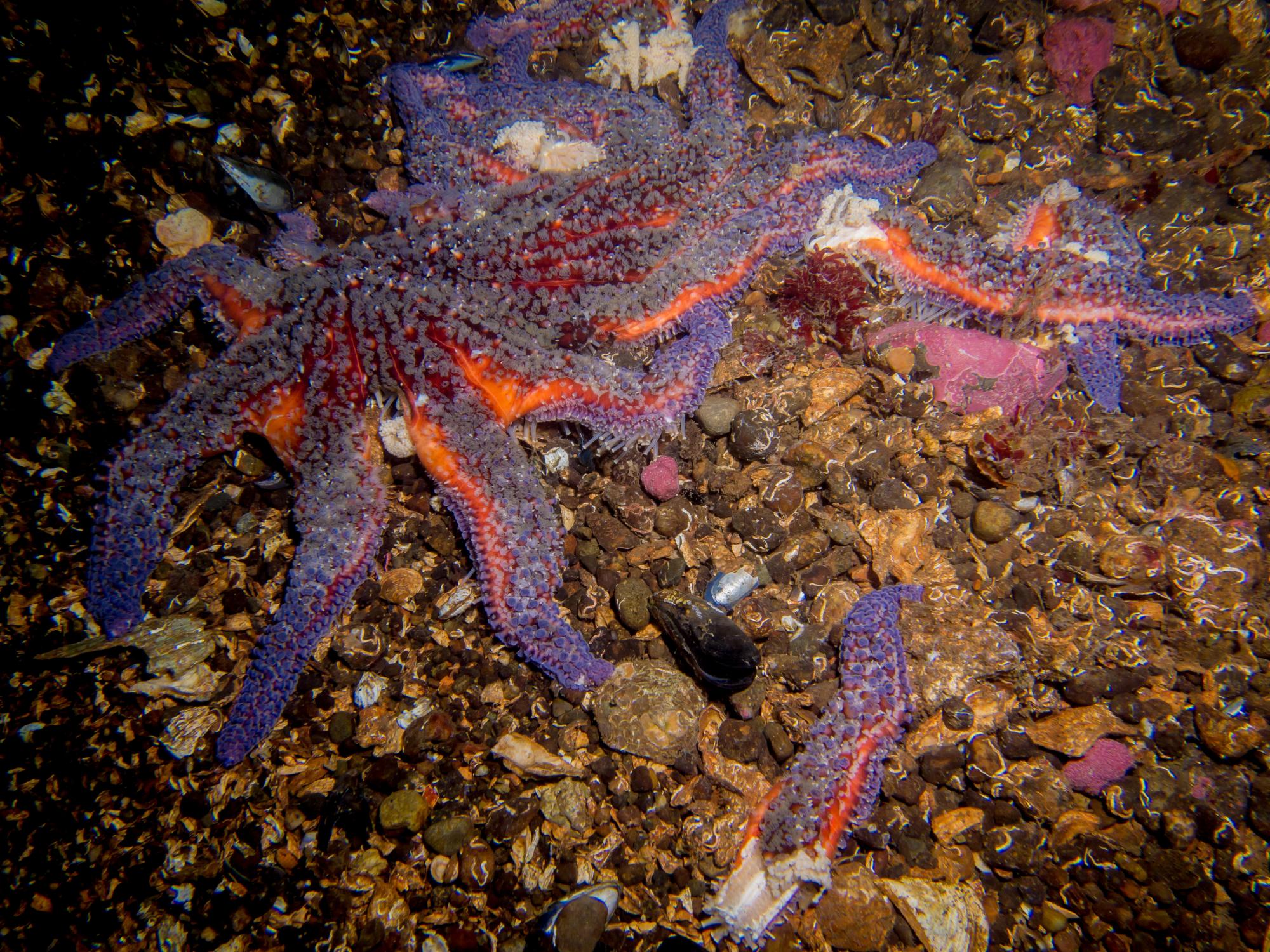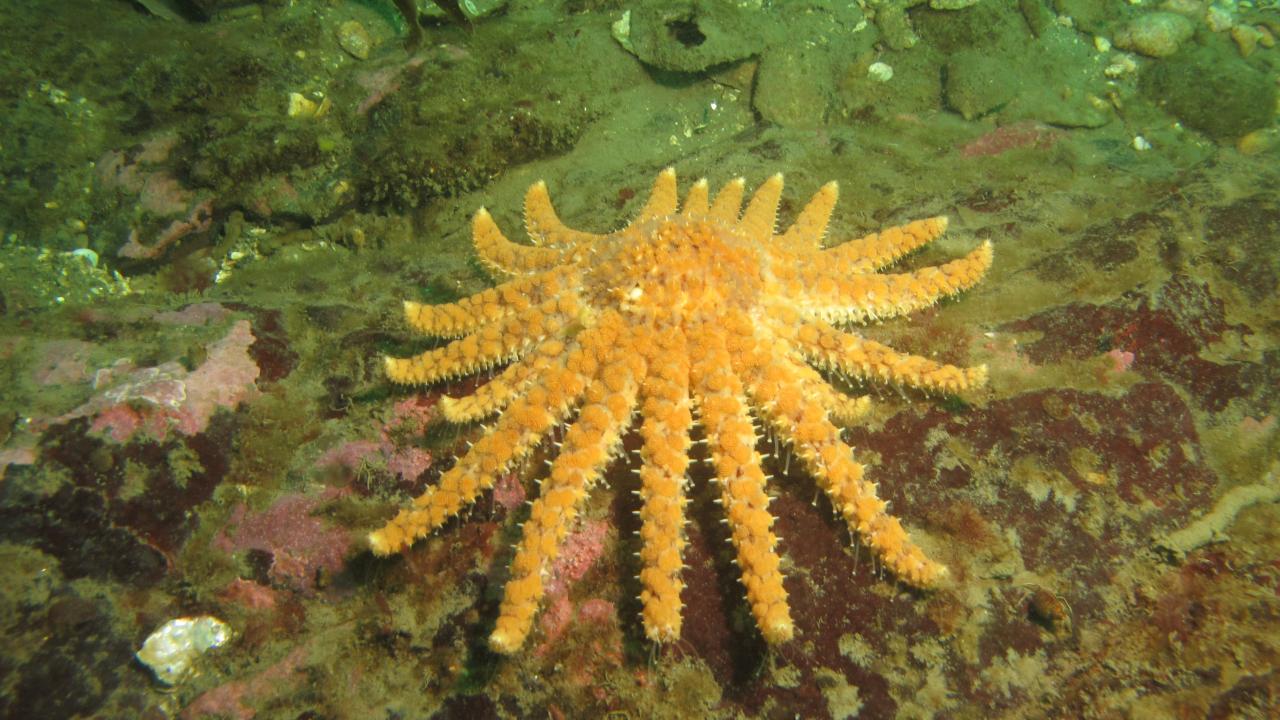Quick Summary
- Survey shows sea stars of the Salish Sea hit hard by mysterious wasting disease
- Sea stars are key predators, keep other animals in check
Sea star wasting disease has devastated intertidal populations of these animals on the West coast from Mexico to Alaska. But what about sea stars that live below the low tide line, mostly out of sight? An analysis of data collected by divers in the Salish Sea shows severe impacts on some species, especially the sunflower sea star, Pycnopodia helianthoides.
“Sunflower stars are major predators. This is probably going to change the shape of the ecosystem,” said Joe Gaydos, wildlife veterinarian and chief scientist with the UC Davis School of Veterinary Medicine's SeaDoc Society, which carried out the analysis with colleagues from Cornell University. The findings, published Oct. 26 in the journal PLOS One, reflect anecdotal reports from elsewhere on the West coast, he said.
Sea star wasting disease broke out in 2013, causing massive death of several species of sea stars. Infected animals develop lesions that eat away tissue, with limbs dropping off as the animals die. The disease has been linked to a virus, although environmental factors may also be involved.
“The sunflower star is the most susceptible species, so we were concerned that it could be driven way down by this nonspecific virus,” said co-author Drew Harvell, professor of ecology and evolutionary biology at Cornell University.
The Salish Sea, which straddles the U.S./Canadian border and includes Puget Sound and the waters east of Vancouver Island, is home to a diverse population of sea stars. The animals are important predators, eating urchins and other animals.
“The Salish Sea is known worldwide for sea star diversity, so we wanted to know, What is the impact on different species?” Gaydos said.
The researchers used a combination of data collected by scientific divers during 2014-15 and long-term data collected by trained recreational scuba divers through the Reef Environmental Education Foundation, or REEF.
“The REEF data were amazing. We were able to compare eight years of pre-epidemic data to the outbreak to show how devastating declines were for the sunflower stars,” said Diego Montecino-Latorre, UC Davis graduate student, veterinarian and lead author on the study.
Sunflower sea stars hit hard

The results showed some species were hit hard, while others actually increased in number. Populations of sunflower sea stars dropped dramatically after the beginning of the epidemic, and several other sea star species, including the spiny pink star, Pisaster brevispinus, also declined. Numbers of the less-common leather star (Dermasterias imbricata) and two species of sea urchin, which are prey for sea stars, increased after 2013.
The virus outbreak continues, and will have lasting effects on the ecosystem. Sunflower sea stars have effectively disappeared from the Salish Sea, the study concludes. Likely as a result, numbers of urchins have increased, which in turn will lead to more grazing on kelp. Gaydos said that he and his colleagues are in discussions with the National Marine Fisheries Service to get the sunflower sea star listed as a “species of concern.”
“This study revealed the need to generate a plan supporting the persistence of what used to be the most common sea star species in the Salish Sea,” said Montecino-Latorre.
The SeaDoc Society is a program of the Karen C. Drayer Wildlife Health Center, UC Davis School of Veterinary Medicine.
Other authors on the study: Morgan Eisenlord and Reyn Yoshioka, Cornell University; Margaret Turner, Northeastern University, Nahant, Massachusetts; and Christy Pattengill-Semmens and Janna Nichols, Reef Environmental Education Foundation, Key Largo, Florida.
Media Resources
Joe Gaydos, 360-914-1083, jkgaydos@ucdavis.edu
Andy Fell, UC Davis News and Media Relations, 530-752-4533, ahfell@ucdavis.edu
